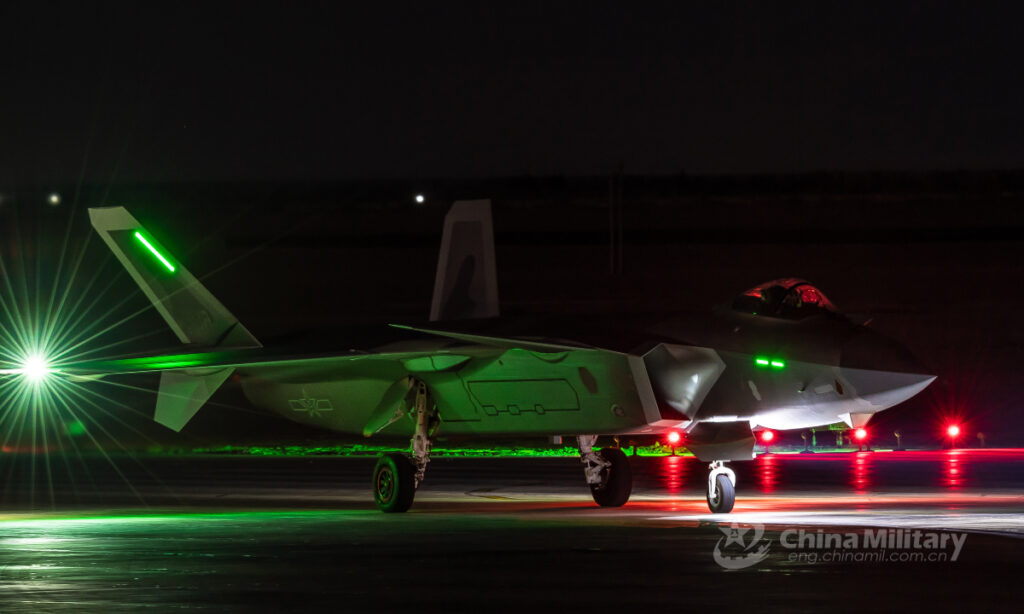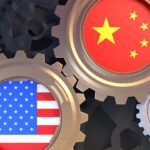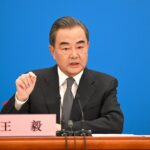Joint military exercises around the island of Taiwan by the Chinese People’s Liberation Army (PLA) continued Wednesday with a joint blockade, sea assault and land and air combat trainings, involving the use of advanced weapons including J-20 stealth fighter jets and DF-17 hypersonic missiles after the drills started on Tuesday evening, when US House Speaker Nancy Pelosi landed on the island which seriously violates China’s sovereignty.
The exercises are unprecedented as the PLA conventional missiles are expected to fly over the island of Taiwan for the first time, the PLA forces will enter area within 12 nautical miles of the island and that the so-called median line will cease to exist, experts said, noting that by surrounding Taiwan entirely, the PLA are completely blockading the island demonstrating the Chinese mainland’s absolute control over the Taiwan question.
The PLA Eastern Theater Command on Wednesday organized its affiliated Navy, Air Force, Rocket Force, Strategic Support Force and Joint Logistic Support Force and conducted realistic combat-oriented joint exercises in the sea and air space to the north, southwest and southeast of the island of Taiwan, the PLA Eastern Theater Command said in a press release on the day.
Joint blockade, sea assault, land attack and air combat drills were at the core of the operation, as the exercises tested the troops’ joint operational capabilities, said the press release.
The J-20 stealth fighter jet, H-6K bomber, J-11 fighter jet, Type 052D destroyer, Type 056A corvette and DF-11 short-range ballistic missile are among the weapons used in the drills, as shown in the photos attached to the press release.
Early warning aircraft and DF-17 hypersonic missiles also joined the exercises, according to a report by China Central Television.
Wednesday’s drills came after the PLA Eastern Theater Command started joint military operations around the island of Taiwan on Tuesday evening, involving joint maritime and air exercises in the sea and in the air space to the north, southwest and southeast of the island of Taiwan, long-range live-fire shooting in the Taiwan Straits, and conventional missile test launches to the east of the island of Taiwan.
The PLA will also conduct important military exercises and training activities including live-fire drills in six large maritime areas and their air space surrounding the island of Taiwan, in its north, northeast, east, south, southwest and northwest, from Thursday noon to Sunday noon, the Xinhua News Agency reported on Tuesday evening.
Unprecedented actions
This is the first time the PLA will launch live long-range artillery across the Taiwan Straits, in a move that will demonstrate the PLA’s firm will and strong capability to safeguard national sovereignty and territorial integrity, and thwart secessionist attempts by “Taiwan independence” and external interfering forces, Zhang Junshe, a senior research fellow at the Naval Research Academy of the PLA, told the Global Times on Wednesday.
“If the conventional missiles of the PLA were to be launched from the mainland toward the west of Taiwan and hit targets to its east, this means that the missiles would fly over the island, which is unprecedented,” Chinese mainland military expert Zhang Xuefeng told the Global Times.
He also pointed out that five of the drill zones are set to the east of the so-called median line of the Taiwan Straits, and this means that the existence of the line is denied through the concrete action of the PLA.
Some drill zones are also for the first time set to include areas within 12 nautical miles to the island of Taiwan, but since Taiwan is a part of China, Taiwan’s so-called territorial sea is also China’s territorial sea, Zhang Xuefeng said.
Also, the PLA drills surrounding Taiwan are intended to show that it is capable of blockading the entire island and of resolving the Taiwan question through non-peaceful ways, if the situation becomes irretrievable, observers said.
From the designated PLA military drills area, the operations could pose a threat to major ports and shipping lanes in Taiwan, forming a complete blockage. This blockage style could be one of the action plans taken in the future for achieving the reunification by force, Herman Shuai, a retired Taiwan lieutenant general, told the Global Times on Wednesday.
Two northern exercise areas designated by the PLA are located off the coast of Keelung Port and Taipei Port, the central exercise area is located off the Taichung Port, the southern exercise area is located off the Kaohsiung Port and the eastern one is located off the Hualien Port. The exercise areas are a “template” for “locking down Taiwan,” Shuai said. “If the PLA exercises take a long time, it will constitute a substantial blockage of Taiwan.”
The PLA’ s drills this time are “comprehensive and highly targeted,” showing the determination of resolving Taiwan question once and for all, Chinese mainland military expert Song Zhongping told the Global Times on Wednesday.
The drill should be viewed as a war plan rehearsal, Song said, “In the event of a future military conflict, it is likely that the operational plans currently being rehearsed will be directly translated into combat operations.”
“It means that our battle plan has been made clear to the US and the Taiwan authorities, and we are confident enough to inform them of the consequences of further provocation in this way,” Song said.
Comparing to the Taiwan Straits crisis in 1996, the PLA’s military strength has been greatly enhanced, analysts say.
“In 1996, we didn’t have aircraft carriers, the Type 055 large destroyer, nor hypersonic missiles… Since then our ability to strike, capture and kill has greatly improved and our military options and confidence have increased,” Song said.
Shuai believes that in 1996, Taiwan’s self-defense capabilities were relatively strong, the PLA’s projection capabilities were still insufficient, and the number of amphibious warfare ship was limited. Also the PLA’s Navy Marine Corps as well as Air Force did not have absolute advantages.
Therefore, at that time, the PLA did not have the capability of completely blocking the island. It only used the method of test-launching missiles to send warnings, but it did not pose any threat to the open seas of Taitung and Hualien, not to mention to US aircraft carriers, Shuai said. “But it is different now. After so many years of rapid development, the PLA, whether it is with the Type 055 large destroyer, aircraft carriers or amphibious landing ship, now fully possesses the strength to blockade the Taiwan Island.”
As Pelosi’s flight was about to land, Chinese state media reported that a Su-35 fighter jet(s) of the PLA Air Force was flying across the Taiwan Straits, but Taiwan’s defense authority later claimed this is fake news.
It only exposed Taiwan’s weak air defense which failed to detect the PLA aircraft, observers commented.
Not intercepting Pelosi’s flight does not mean a failure of the PLA. On the contrary, the Chinese mainland chose to avoid an incident that could trigger a World War III but instead to take Pelosi’s Taiwan visit as a chance to push forward the progress of reunification, starting with the island-blockading, combat-rehearsing drills that could become routine, analysts said.
Mainland authorities announced on Wednesday that a number of diehard “Taiwan secessionists”, two funds and multiple companies related to secessionist activities will be punished in accordance with the law.
Zhang Hua, an associate research fellow at the Institute of Taiwan Studies, the Chinese Academy of Social Sciences, told the Global Times on Wednesday that the law on punishing Taiwan secessionists is complete and in place in the mainland.
Taiwan secessionists can be judged according to Criminal Law for splitting the country, destroying the reunification of the motherland and endangering national security, the expert said.
Zhang Wensheng, deputy dean of the Taiwan Research Institute at Xiamen University, told the Global Times on Wednesday that after the reunification, the Chinese mainland can collect evidence against Taiwan secessionists in accordance with criminal law, set up special courts to try them in absentia, and nail all those at large wherever they are.
In addition, the scope of sanctions can be extended to the family members of Taiwan secessionists, which means they’ll be banned from business exchanges with the mainland and the institutions they work for should also be included in the sanctions list, Zhang said.
Mainland experts said that it cannot be ruled out that more regulations against Taiwan secessionists will be adopted in the future. Considering that the Anti-Secession Law is more of a framework and principle law, the central government could formulate a specific law targeting Taiwan secessionists, similar to the national security law for the Hong Kong Special Administrative Region.
(Global Times)




